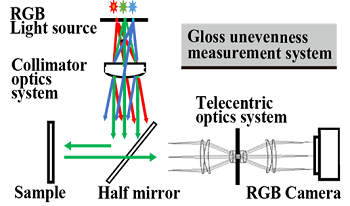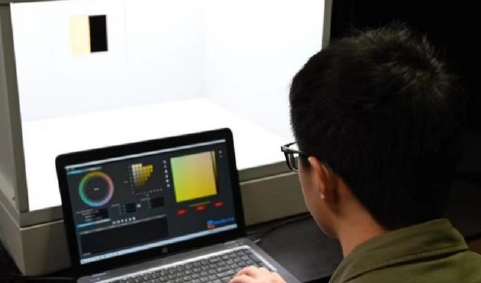
In this paper, we introduce the analysis for gloss unevenness by using developed multiple directional incident lights optics. Gloss unevenness is strongly related to recognition of material texture. However, it looks different depending on the angles, so it has been difficult to measure quantitatively. The gloss unevenness caused by surface roughness is able to analyze by the distribution of normal on the surface. We have developed the optical system that simultaneously illuminates with light from three different directions, angles, and captures images of gloss unevenness in one shot. We confirmed that the normal distribution of the surface can be estimated by analyzing the image. This proposed method can not only measure the gloss unevenness image, but also estimate the shape of the surface. As an application of this gloss unevenness observation technology, it is also possible to detect of scratches and coating unevenness in industrial quality control.

This paper describes LEDSimulator, a system that exhibits the impact of texture on colour appearance and serves as a colour communication tool for supply chain management. LEDSimulator is capable of accurately displaying coloured textures, achieving successful colour reproduction between media, and expediting the production cycle. The key technologies that accomplish this are introduced here, including: 1) visual colour matching on textures, 2) projector characterization modeling using the conventional and an advanced reduced LUT approach, and 3) a model to achieve metameric cross-media reproduction.

The digital representation of three dimensional objects with different materials has become common not only in the games and movie industry, but also in designer software, e-commerce and other applications. Although the rendered images often seem to be realistic, a closer look reveals that their color accuracy is often insufficient for critical applications. Storage of the angledependent color properties of metallic coatings and other gonioapparent materials demands large amounts of data. Apart from that, also rendering sparkle, gloss and other visual texture phenomena is still a subject of active research. Current approaches are computationally very demanding, and require manual ad-hoc setting of many model parameters. In this paper, we describe a new approach to solve these problems. We combine a multi-spectral physics-based approach to make BRDF representation more efficient. We also account for the common loss in color accuracy due to the varying technical specifications of displays, and we correct for the influence from ambient lighting. The rendering framework presented here is shown to be capable of rendering sparkle and gloss as well, based on objective measurement of these properties. This takes out the subjective phase of manual fine-tuning of model parameters that is characteristic for many current rendering approaches. A feasibility test with the new spectral rendering pipeline shows that is indeed able to produce realistic rendering of color, sparkle, gloss and other texture aspects. The computation time is small enough to make the rendering real-time on an iPad 2017, i.e. with low memory footprint and without high demands on graphic card or data storage.